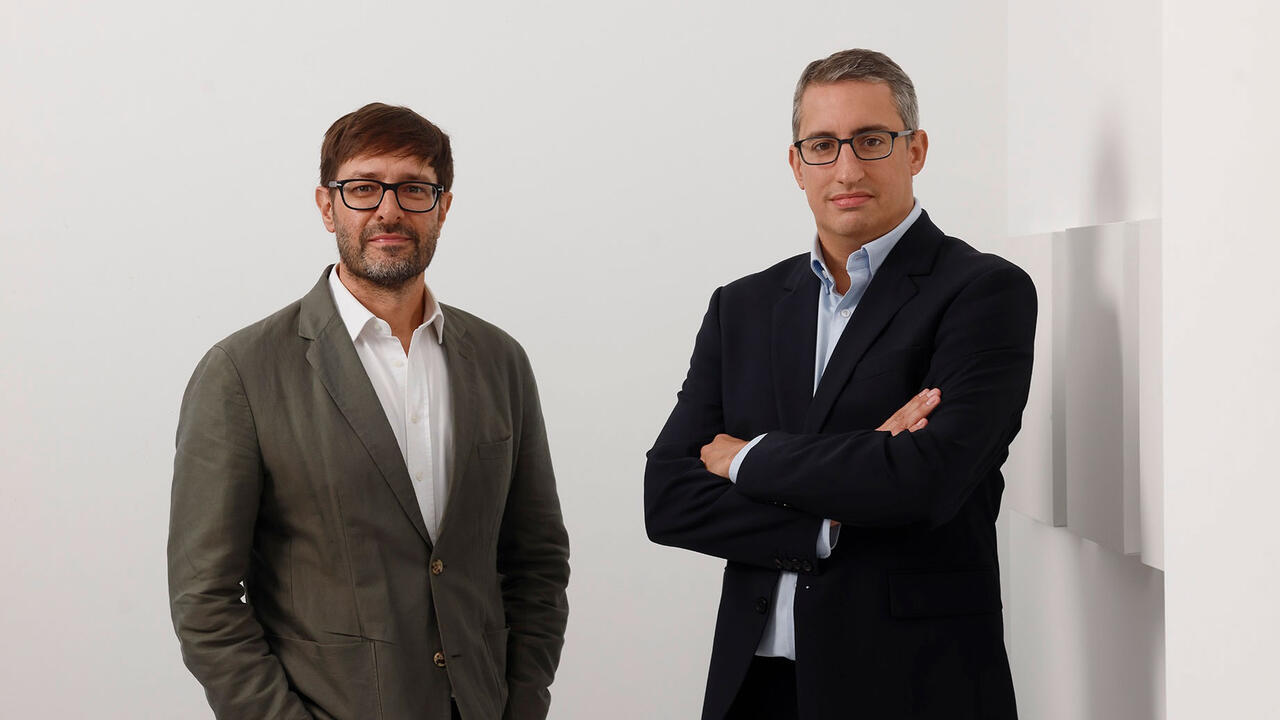Oscar Murillo

The title of Oscar Murillo’s first London solo show was a mouthful: ‘Dinner at the members club? Yes! i’ll have a black americano first pls’. The titular ‘black americano’ in this case was – by his own admission – none other than the young London-based artist himself, whose Colombian origins are often emphasized in his painterly and performance-based practice (though there were also packs of ground coffee at the gallery, which visitors were welcome to take home). ‘The members club’ was apparently a reference to the ICA committee who had invited Murillo to rustle up something nice and performative for their annual fundraising dinner. He was happy to oblige: his debut exhibition at Carlos/Ishikawa became the setting for a champagne lunch, prepared by the artist with his relatives and served on grimy tablecloths made of ornate fabrics that had been gathering dirt for the occasion.
Welcome to the members club (all works 2013) is also the title of a 42-minute video, which documents the making of lollipops at the factory that employs most people in Murillo’s hometown, La Paila, in the southeast of Colombia. (Packed into boxes on one of the two platforms in the main space, the freely available sweets inevitably recalled Félix González-Torres’s candy piles.) But the artist doesn’t consider rough-and-ready, handheld videos such as this one to be art works in their own right; rather, he uses them to set his practice in context. A similar role is assigned to the social gatherings – such as dinners, yoga sessions, games or dances – that Murillo refuses to call ‘performances’ (though others do that for him), because they strike him as a natural, spontaneous outgrowth of his work, as opposed to an exercise in relational aesthetics of the kind practiced by, say, Rirkrit Tiravanija and his peers.
When it comes to Murillo’s broader output, it’s not always easy to determine what is ‘work’ proper and what is mere support. In a sense, everything at Carlos/Ishikawa was folded into his work’s sociable sphere for the duration of the show, and most of the things on display could be bought when they were not freely given. Yet not all of the objects had the same status. For example, one of the exhibition’s most distinctive features – the reflective copper sheets laid over a low plywood structure – were not art as such, according to the artist, but rather work-in-the-making (to be shown at a later date in a different gallery). Three weeks after the opening, these had lost some of their sheen and were looking tarnished – precisely the effect Murillo strives for. Instead of presenting a finished product, the artist wanted this exhibition to reflect some of the processes that inform his studio practice.
Painting forms the backbone of Murillo’s artistic practice, though rather than a brush he often uses a broom stick and a sizeable oil paint pad, in a sort of rudimentary mono-printing technique. Roughly hewn, stitched-up canvases in two or three different sizes – mostly large – and as many varieties (he calls them ‘banners’, ‘stack paintings’ and ‘bingos’) were hung on, leaned or stacked up against all available walls. Before the mark-making process begins, these are left lying about for a month or two to wear them in and let them gather ‘information’ (what the artist has referred to as the ‘DNA of the studio’). Murillo, who sees mess as a generative force, makes it a point never to tidy up his work environment. There is an archival element to much of the artist’s production, which retains traces of former activities, whether in the shape of single, underscored words and numbers (‘work’, ‘yoga’, ‘poker’, ‘maiz’, ‘3’) that feature prominently on his canvases, or condensed into solid dirt balls made up of studio débris (pulped drawings, thread, cement dye, copper, dust) dotted around the gallery.
‘Dirt’, and sometimes ‘dirt on canvas’, is insistently listed among the artistic media in Murillo’s works. More than just a widely available material, dirt for the artist has a levelling effect: we all experience it, black and white, rich and poor alike. In his eyes, that’s what makes it ‘democratic’. It’s easy to dispute this claim. Dirt is, after all, socially stratified; it belongs to the streets, to some more than others, and grows more scarce the higher one climbs. In some quarters (the art world among them), dirt can be exotic, a rarefied commodity, the mark of originality.
Murillo evidently sees himself as a mediator between different demographics, facilitating encounters between two worlds that would not normally meet – namely the art crowd and the Latin American immigrant community – through the events that he organizes. And yet, at the rehearsal fundraising lunch at Carlos/Ishikawa, the artist’s relatives who cooked tamales for us sat at their own table. The event may well have been intended as a critical comment on the exclusivity of the artist’s dinner, but the message it ultimately put across was as confusing as the exhibition’s title.
















